Key takeaways:
- Vintage toys evoke nostalgia and connect us to childhood, showcasing cultural values and design trends of their time.
- Upcycling reduces waste, fosters creativity, and preserves memories, allowing us to transform old items into unique, meaningful creations.
- Teaching sustainability through upcycling toys engages younger generations in eco-friendly practices while enhancing sentimental value.
- Successful upcycling involves selecting emotionally significant pieces, choosing suitable materials, and being patient throughout the creative process.

Understanding vintage toys
Vintage toys hold a special place in many of our hearts, often evoking a sense of nostalgia that connects us to our childhood. I remember finding an old tin robot in my grandmother’s attic, its painted surface scratched but full of charm. Have you ever wondered how such simple creations could spark endless joy and imagination?
Understanding vintage toys means delving into the stories behind them. Each toy reflects the era it was made in, showcasing the design trends and cultural values of that time. For instance, when I discovered a set of wooden building blocks, I was struck by the craftsmanship and simplicity that encouraged creativity long before digital screens took over playtime. Doesn’t it make you think about how today’s toys compare in fostering hands-on experiences?
The emotional impact of vintage toys often extends beyond play; they serve as a tangible link to our past. When I restored a well-worn teddy bear, the act of bringing it back to life felt like a bridge connecting me to my younger self. In this light, vintage toys become more than mere objects; they encapsulate memories and the joy of simpler times. Have you experienced that same sentiment with any of your childhood treasures?
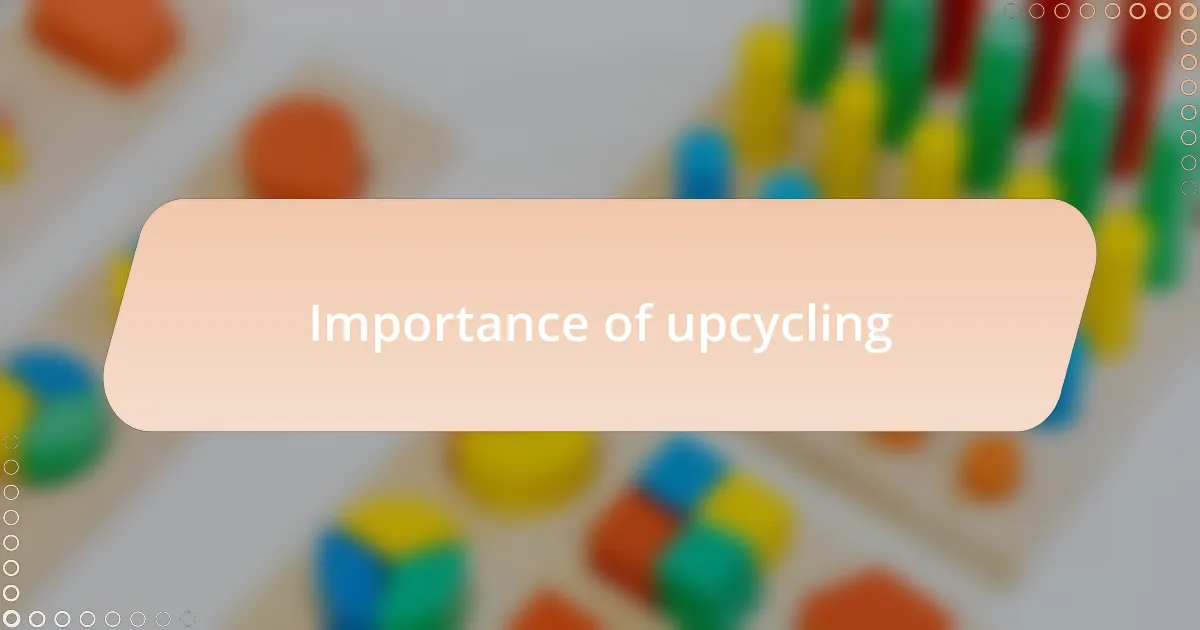
Importance of upcycling
Upcycling plays a crucial role in reducing waste, and it’s something I’ve grown increasingly passionate about. When I decided to transform an old toy chest into a stylish coffee table, I not only salvaged a family heirloom but also prevented it from ending up in a landfill. Isn’t it amazing how one project can breathe new life into something that was once considered obsolete?
Beyond environmental benefits, upcycling fosters creativity and innovation. I remember the thrill of turning mismatched vintage toy pieces into quirky art displays. I found that each project helped me explore new ideas and materials, sparking joy and satisfaction in ways that simply buying new items never could. Have you ever looked at discarded toys and imagined what they could become?
Moreover, the act of upcycling carries a profound emotional weight. As I reimagined an old plush toy into a decorative pillow, I felt a deep sense of connection to the memories attached to it. In this way, upcycling isn’t just about restoring items; it’s about preserving stories and emotions while creating something uniquely yours. How do your sentimental items inspire creativity in your life?
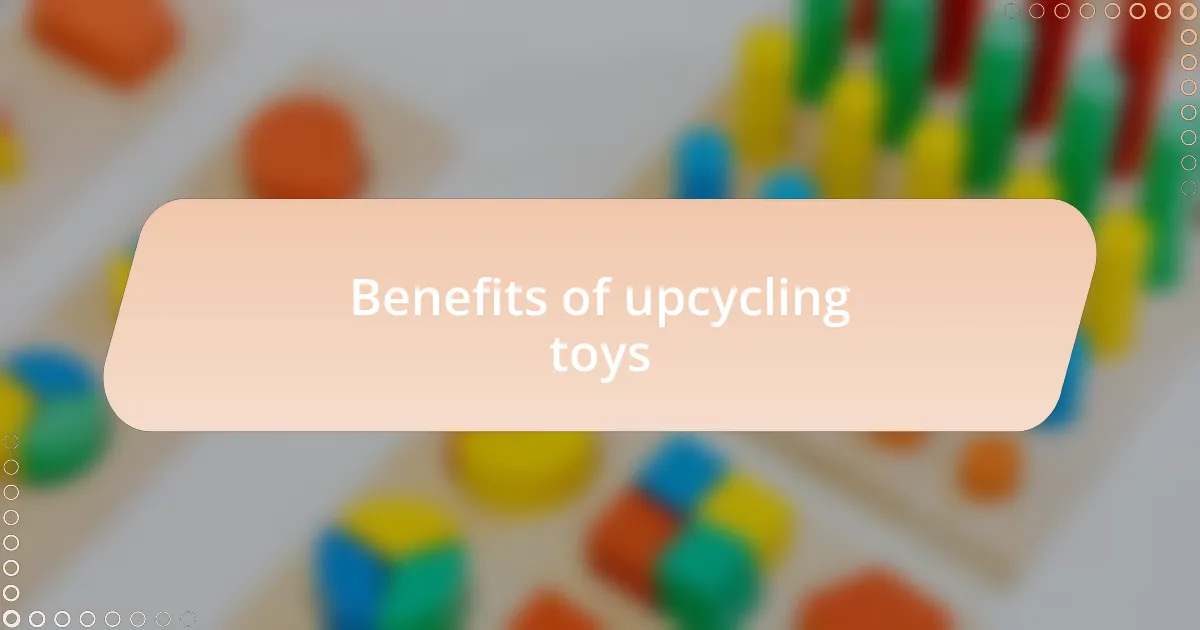
Benefits of upcycling toys
Upcycling toys offers a unique chance to teach sustainability to the younger generation. I vividly recall spending an afternoon with my niece, transforming an old toy truck into a fun planter for flowers. As we painted and arranged the plants, I noticed that she was not only excited about the project but also curious about where the plants came from and the importance of reusing materials. How rewarding is it to see kids embrace eco-friendly practices through creative play?
Another benefit is the way upcycling enhances the sentimental value of toys. I once converted a box of my childhood action figures into a whimsical shadow box for my home. Every time I glance at it, I’m flooded with memories of epic adventures, and it feels like I’ve created a tangible portal to my past. Can you think of a beloved toy that could spark similar nostalgia when reimagined?
Finally, upcycling toys can be a fantastic way to develop new skills, especially if you enjoy crafting and DIY projects. After rerouting electronics from an old toy into a lamp, I discovered a knack for basic wiring and design, something I never thought I’d enjoy. The process was not just educational; it also ignited a newfound passion for creating custom pieces that tell a story. How has your own creative journey taught you unexpected skills?
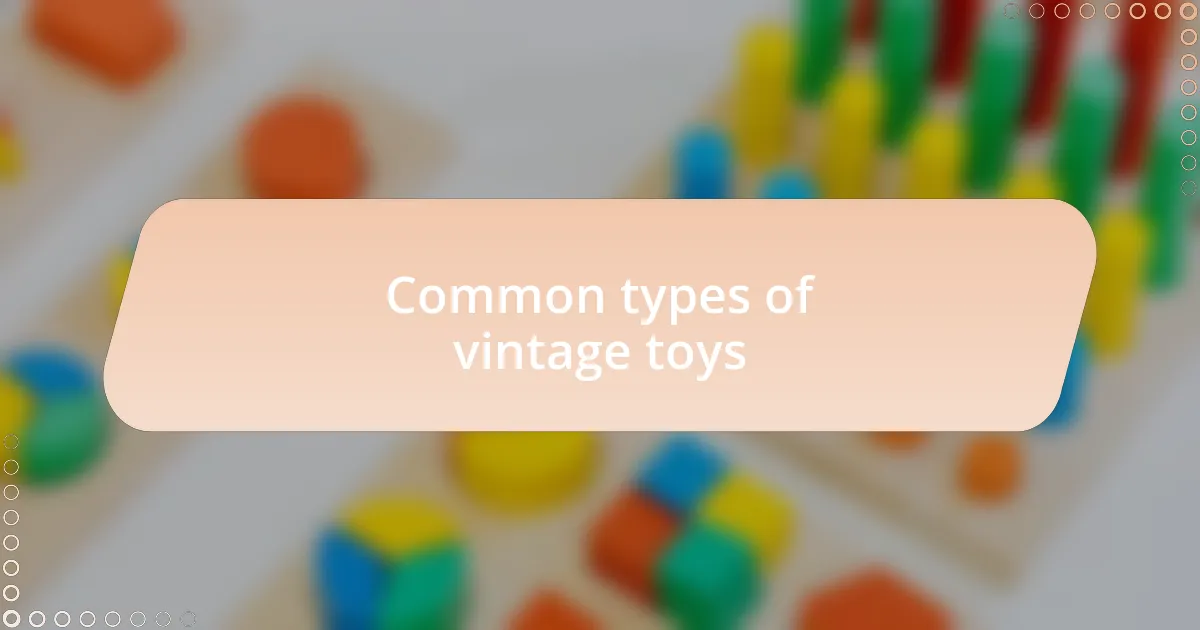
Common types of vintage toys
When it comes to vintage toys, the classics often reign supreme. I have always been drawn to wooden toys, particularly the beautifully crafted heirloom pieces that have stood the test of time. Each one carries its own charm, transporting me back to simpler days when imagination was the key to entertainment. Have you ever felt that nostalgic pull when encountering a handmade toy that radiates warmth?
Another common type is metal tin toys, which often feature delightful designs and mechanisms, like wind-up action or friction-powered movement. I still remember the joy of unearthing a vintage robot with its colorful paint and spinning gears. The intricate details not only fascinated me as a child but also sparked an appreciation for the craftsmanship that went into making them. Isn’t it remarkable how a small metal toy can evoke such strong feelings simply because of its history?
Lastly, plush toys hold a special place in the hearts of many. I have a cherished collection of vintage stuffed animals, each with its own unique story and little imperfections that add character. They serve as a reminder of comfort and companionship. Have you ever tucked a well-loved teddy bear under your arm and felt that rush of warmth? Vintage plush toys remind us of the comfort that comes from parental love and the joy of childhood playtime adventures.
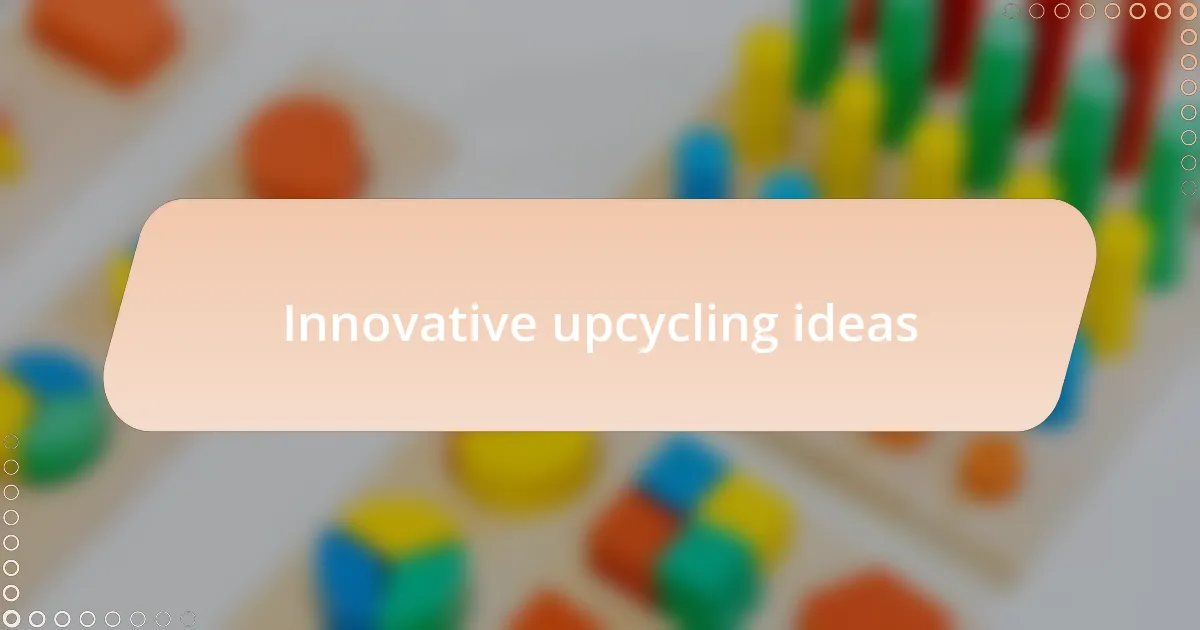
Innovative upcycling ideas
One innovative upcycling idea I embraced was transforming old toy cars into quirky planters. I vividly remember when I first painted a bright blue vintage race car and added small succulents to its backseat. It was delightful to see it become a vibrant addition to my windowsill, reminding me that even the smallest toys could create a piece of life and color in my home. Have you ever thought about how a childhood favorite could evolve into a stylish décor item?
Another project involved turning a collection of mismatched building blocks into a decorative photo frame. I found this to be a creative way to showcase my favorite childhood snapshot, and the charmingly irregular shapes made it feel uniquely personal. As I assembled it, I couldn’t help but reflect on the countless hours I spent building imaginative worlds with those very same blocks. Isn’t it fascinating how a little effort can breathe new life into our old treasures?
Lastly, I had a blast crafting a unique wall art piece from vintage dolls. I carefully arranged their heads, painting the backgrounds with vivid colors to create a statement piece that sparked conversations in my living room. The startled looks from guests always made me chuckle, as they pondered the origins of the characters. Have you ever considered how the blend of nostalgia and creativity can lead to something striking and memorable?
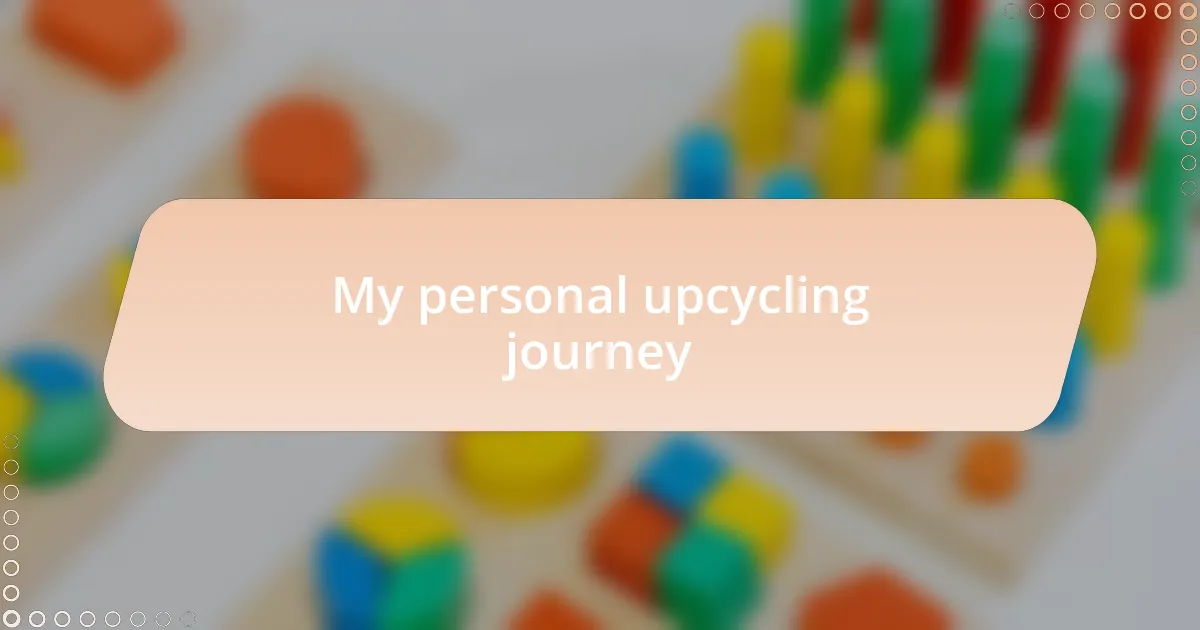
My personal upcycling journey
Taking the plunge into upcycling toys was a game changer for me. I still remember the moment I picked up a battered teddy bear that had once been my best friend; its fur was matted and its button eyes were missing. Instead of tossing it aside, I decided to give it a makeover, sewing on new fabric and stitching a smile that reminded me of our countless adventures. That transformed stuffed animal became a symbol of resilience, teaching me that even the most worn items can regain their charm.
One day, I stumbled upon a box of forgotten action figures while clearing out my attic. Instead of letting them collect dust, I decided to turn them into unique bookends for my shelf. As I glued them to sturdy wooden blocks, I found joy in rediscovering their stories. Each figure felt like a portal back to my childhood, offering a strange comfort amid the pressures of adulthood. Is there anything more satisfying than merging nostalgia with functionality?
During my journey, I encountered setbacks, like the time I mishandled a spray paint can and ended up with a polka dot disaster on my new project. At first, I was frustrated, but then I realized I could embrace the imperfections and turn them into a unique design. This taught me an important lesson: creativity often grows from messiness, and sometimes the unexpected turns into something truly beautiful. Have you ever let a supposed mistake inspire you?
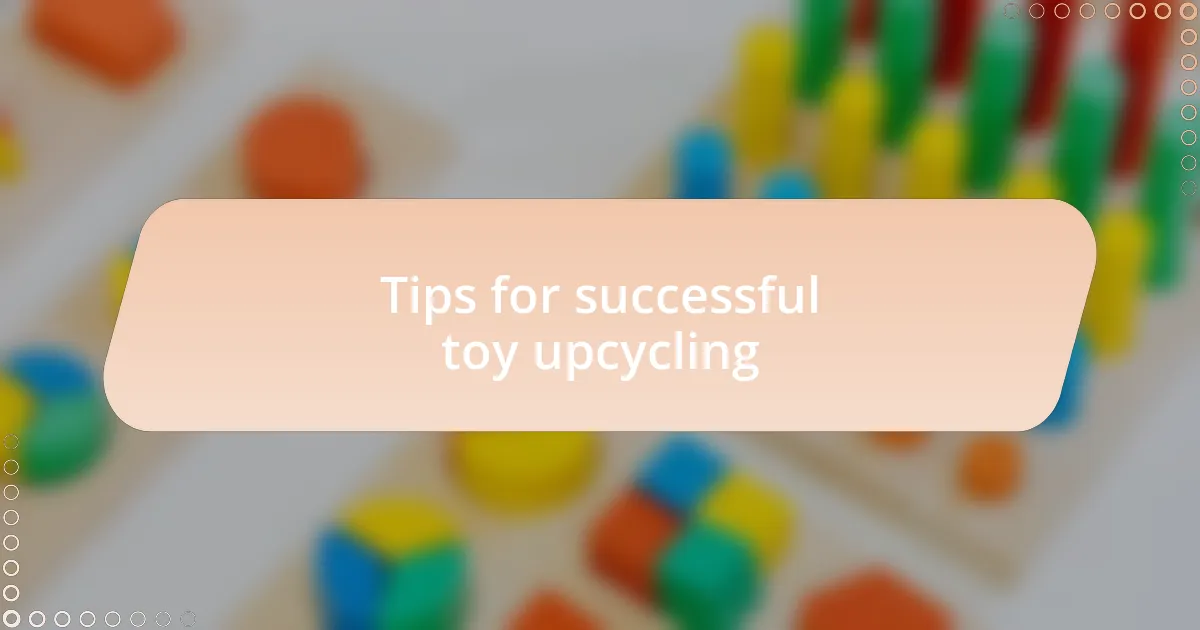
Tips for successful toy upcycling
When diving into toy upcycling, start by selecting pieces with a strong emotional connection. I’ve found that transforming toys that hold memories makes the process even more satisfying. Have you ever wondered how a simple change can breathe new life into something cherished? For instance, I once transformed a classic game board into a vibrant serving tray, infusing it with a blend of nostalgia and functionality that enhances my gatherings.
Choosing the right materials is another vital aspect of successful upcycling. When I crafted a puppet out of an old sock, using fabric paint for the facial features saved time and frustration. It’s amazing how easy it is to make something unique when you allow yourself to think outside the box. What materials inspire you to create? Remember, it’s about seeing potential where others might see clutter.
Patience is crucial. I learned this during a project where intricate details made all the difference in the final look. Initially, I rushed and ended up unhappy with the results. Instead, I found that taking my time to carefully plan and execute each step led to a piece I proudly display. Have you experienced the rewards of slowing down in your creative journey? Turning upcycled toys into treasures requires a careful balance of excitement and patience.